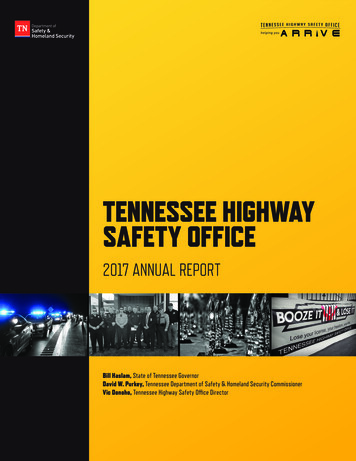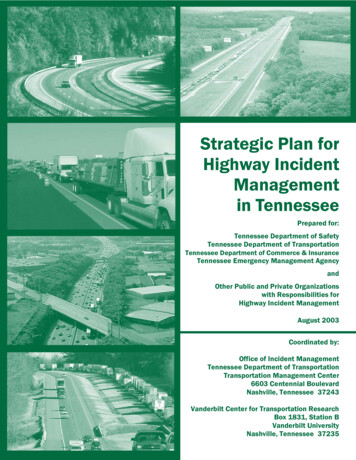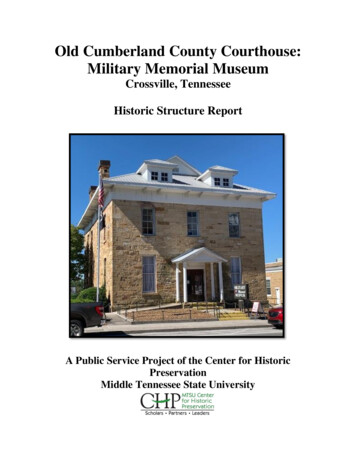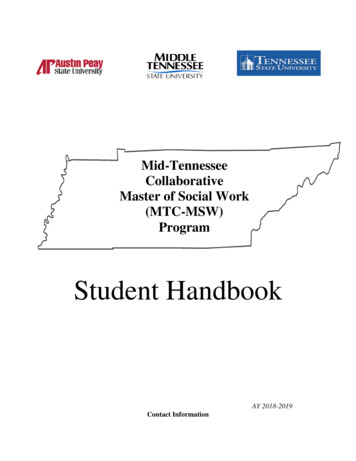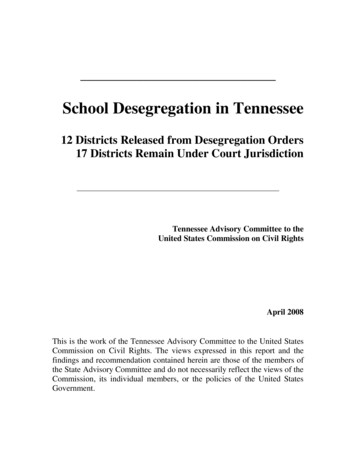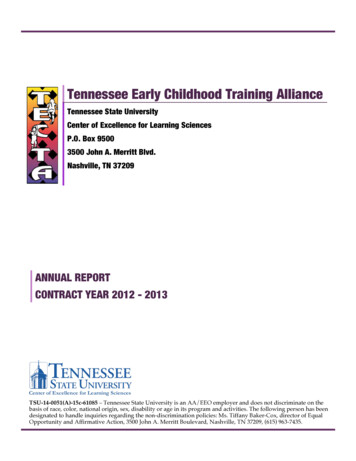
Transcription
Tennessee Water Resources Research CenterAnnual Technical ReportFY 2015Tennessee Water Resources Research Center Annual Technical Report FY 20151
IntroductionWater Resources Issues in Tennessee:The southeastern United States historically has been considered water-rich. However, the U.S. Global ChangeResearch Program (USGCFP) in their 2014 National Climate Assessment Report(http://nca2014.globalchange.gov/report) has projected less frequent precipitation and more frequent dayswith higher temperature. As a result, we will see increased evapotranspiration and frequency ofdrying-and-wetting cycles. These changes will lead to deficits in both soil moisture and surface/ground waterstores, and hence more droughts.The increased drying-and-wetting of the soils will also weaken aggregates through repeated shrinking andswelling. Then higher intensity rains will cause extreme erosion events, washing away soil nutrients andcontaminants. The subsequent degrading water quality will further limit water availability.Beginning in 2006 and continuing on through the summer of 2008, Tennessee experienced a drought of recordwhich severely strained the water supplies of many communities across the state. During this period over 35water districts out of a total of 671 public systems in Tennessee experienced difficulty in supplying water totheir customers. In recent years, many of the smaller municipal water suppliers and utility districts that rely onwells, springs, or minor tributaries for their water sources continue to face water shortage problems. All acrossthe state many private, domestic, and commercial use wells have become strained, forcing users to seekalternative sources of water.In addition to the effects of climate changes on water availability, there is an increased demand from a risingpopulation and shifting land use distributions. These changes in demand are especially significant in adjoiningurban and agricultural areas around Tennessee.Withdrawals for municipal purposes are the fastest growing water-use category, rising 8% annuallynationwide. Significant amounts of water are required to generate electricity through hydropower, as well asfor cooling fossil fuel and nuclear power plants. These uses, which can be voluminous, can alter natural flowsand influence the health of aquatic ecosystems. Along the same lines, higher food production will increasewater demand for agriculture. Irrigation for agriculture is the largest water use and can diminish supplies forother uses. It also has the potential to degrade water and soil quality.With more and more people migrating to cities, this demand may lead to a water crisis. As mentioned above,water shortages are occurring more often and may become problematic in the southeastern U.S., especiallywith groundwater resources dwindling. Shifting water demands may lead to complex natural and humaninteractions that have not been encountered before.Tennessee is fortunate to have what many consider to be an abundance of good quality water. But, from theviewpoint of the state government, the legal, institutional, and administrative aspects of water managementare becoming major concerns. Tennessee has moved to establish an integrated and coordinated policy andadministrative system for managing water resources in the state. It is still a work in progress. For example, theTennessee Water Resources Technical Advisory Committee (WRTAC) has recently joined the effort of otherstates throughout the country and requested the development and maintenance of a statewide hydrologicdatabase to assess the impact of drought on public water supply systems in Tennessee.Providing an adequate supply of quality water for agricultural, industrial, commercial, and domestic uses,while protecting our surface and groundwater resources are of major concern in all regions of the state andvital to the economic development and growth of the state. However, the level of knowledge necessary toIntroduction1
understand the underlying hydrological, biogeochemical and social processes that control the availability ofwater in the state, as well as their interactions and feedbacks, is beyond the capacity of one group or agency tohandle. This necessitates collaboration amongst academia, governmental agencies, and industry to collect andanalyze information for water quality and quantity (WQ2) at any scale and at all times.Tennessee has an active group of federal agencies, such as the Tennessee Valley Authority, Army Corps ofEngineers, Natural Resource Conservation Service, and U.S. Geological Survey (USGS), who havehistorically contributed to the management and monitoring of water resources. In recent years, the state,through the Departments of Environment and Conservation, Wildlife Resources, Agriculture and others, havebegun to develop a more active and aggressive role in the management and protection of these resources.Added to this group, are the cadre of hydrologic and hydraulic researchers at the state s academic institutions,who are working on more fundamental understanding of the hydrologic cycle in light of a changing climateand human development.However, all these groups have been working independently and sometimes in competition, which hasinhibited progress towards a unified front facing the water issues of the state. Tennessee is lacking a singularorganization that has both the vision and the capability to bring these groups together. The Tennessee WaterResources Research Center (TN WRRC) has the right mixture of leadership, outreach, and interdisciplinaryresearch that can unite the different groups and work towards a statewide adaptive governance plan to managethe state's water resources to the benefit of all.Overview of Program Objectives and Goals:The Tennessee Water Resources Research Center, located at the University of Tennessee - Knoxville, is afederally-designated state research institute. It is supported in part by the U.S. Geological Survey of the U.S.Department of Interior under the provisions of the Water Resources Research Act of 1984.The TN WRRC and their university partners provide research expertise in identifying and addressinghigh-priority water problems and issues for each region. It is the primary resource to assist the state & thenation in the development and implementation of programs aimed at achieving sustainable quantities ofquality water. It serves as a link between the academic community, federal/ and state government,water-related organizations, the private sector and local communities for purpose of mobilizing university.The Tennessee Water Resources Research is mandated to do the following by the Clean Water Act:1. Plan, conduct, or otherwise arrange for competent research that fosters the entry of new research scientistsinto the water resources fields; the training and education of future water scientists, engineers and technicians;the preliminary exploration of new ideas that address water problems or expand understanding of water andwater-related phenomena, and the dissemination of research results of water managers and the public.2. Cooperate closely with other colleges and universities in the state that have demonstrated capabilities forresearch, information dissemination, and graduate training, in order to develop a statewide program designedto resolve state and regional water and related land problems.To carry out this mission, the TN WRRC has set these major goals:1. To assist and support all the academic institutions of the state, public and private, in pursuing waterresources research programs for addressing problem areas of concern to the state and region.2. To provide information dissemination and technology transfer services to state and local governmentalbodies, academic institutions, professional groups, businesses and industries, environmental organizations andothers, including the general public, who have an interest in water resources issues.Introduction2
3. To promote professional training and education in fields relating to water resources and to encourage theentry of promising students into careers in these fields.4. To represent Tennessee in the Universities Council on Water Resources, the American Water ResourcesAssociation (including Tennessee Section), the Water Environment Federation, the American Water WorksAssociation, the International Erosion Control Association, the Soil and Water Conservation Society, theLower Clinch Watershed Council, the ORNL-TVA-UT Research Consortium and the National Institutes forWater Resources (NIWR).Tennessee Water Resources Research Center Update:During 2015, the TN WRRC has taken several steps forward to establish itself as a unifying body for thewater resources researchers, managers, and educators in Tennessee. These steps are being driven by the newdirector, Thanos Papanicolaou and Assistant Director Tim Gangaware, who has been with the TN WRRC forseveral years. These steps include the development of an Advisory Board, enhancement of the 104B seedgrant program, and initiation of other state/ national research efforts, as well as sustaining its already strongoutreach efforts.Advisory Board: As an initial step by the TN WRRC to bring together like-minded researchers &administrators across the state, Director Papanicolaou established an advisory board. The board consists oflead personnel from the U.S. Geological Survey, Oak Ridge National Lab, Tennessee Valley Authority, stateagencies like the Departments of Agriculture and Environment & Conservation, and the private sector.Additional members are being considered from the Nature Conservancy and the West TN River BasinAuthority.With the Advisory Board, Director Papanicolaou hopes to garner input on the key water-related issue for thestate. This information will be used to develop the priority areas for the 104B seed grants. After getting thestate water resources organizations involved in the planning of the seed grant program, Director Papanicolaouis working to keep these groups engaged by encouraging them to help provide matching funds for newresearchers, as well as places for the students to gain experience through internships. The first meeting of theAdvisory Board was convened on March 2, 2016 in Knoxville. The second meeting is planned for mid-July inNashville.104B Seed Grants: The focus of the 2015 104B seed grants was on the impact of land management andnutrients on Tennessee s water resources and water/soil management decisions. Excess runoff and soilerosion, resulting from our land management choices affect soil health and landscape productivity, as well aswater quality and quantity across the state. Public awareness of nutrient-related water quality issues is risingand this has put pressure on the state s governing bodies to address these issues through regulation. Theregulatory and mission agencies welcome the focus on understanding better soil and water quality to improvemitigation strategies. The topics submitted in 2015 related to excess nutrients in surface and ground water,soil/sediment sourcing, sedimentation in dams, water quality monitoring, water availability, and landmanagement. We had 5 projects funded in 2015 from researchers at the University of Tennessee andTennessee State University, a Historically Black College/University (HBCU).Introduction3
Research Program IntroductionResearch Program IntroductionThe main push of the TN WRRC research program is through the 104B Annual Base Funding grant program.These base grants are provided to conduct applied research on water resource issues, education for helpingtrain new scientists, and outreach activities to disseminate research results to water managers and the public.They are often used as seed funding for larger projects. Results for TN WRRC supported research efforts areexpected to assist local, municipal, state, regional and federal agencies improve their decision-making in themanagement and stewardship of their water resources.The 104B grants are solicited through an annual call-for-proposals to all the state's colleges and universities.Any full-time faculty member from a Tennessee institution of higher education are eligible to receive grantsform TNWRRC. The call-for-proposals are centered on specific research priorities, but all water resources areconsidered.The focus of the 2015 104B seed grants was on the impact of land management and nutrients on Tennessee swater resources and water/soil management decisions. However, to generate future research priority areas thatare responsive to the water resource issues in Tennessee, Director Papanicolaou has probed the AdvisoryBoard members for suggestions. A list of their suggestions that are being considered for next year are listedbelow in Table 2.Table 2. Potential Topics for the 2016 Research Priorities of the 104B Seed Grants:1. Water availability, water use forecasting, and water transfers;2. Surface water quality monitoring and the need for better sensor technology to get background measures;3. Groundwater remediation (natural attenuation);4. Erosion control and preventive measures; monitoring BMP effectiveness and load reductions before & afterstudies;5. The role of soil heath & cover crops on the hydrologic cycle;6. Sediment sourcing;7. Streambank protection; the using bioengineered structures needed;8. Modeling efforts for sediment especially in west TN.;9. Ecoflows/ minimum flows;10. How to study ecological effects.The following are the project summaries of the five studies conducted under the 2015 program and threeon-going studies from pervious years. The PIs are from the University of Tennessee Knoxville andTennessee State University.Research Program Introduction1
nic Contaminants using Recirculating Packed-Bed Media Biofilters at Decentralized Wastewater Treatment Systems: DetermEngineered Strategy to Remediate Trace OrganicContaminants using Recirculating Packed-Bed MediaBiofilters at Decentralized Wastewater Treatment Systems:Determination of Trace Organic Sorption to TreatmentMediaBasic InformationEngineered Strategy to Remediate Trace Organic Contaminants using RecirculatingTitle: Packed-Bed Media Biofilters at Decentralized Wastewater Treatment Systems:Determination of Trace Organic Sorption to Treatment MediaProject Number: 2013TN99BStart Date: 3/1/2015End Date: 2/28/2016Funding Source: 104BCongressional2nd TennesseeDistrict:ResearchWater QualityCategory:Focus Category: Wastewater, Treatment, Water QualityDescriptors: NonePrincipalJohn R. Buchanan, Jennifer DeBruynInvestigators:Publications1. Buchanan, J.R. 2013. Recirculating media filters providing wastewater treatment at rural schools withammonia discharge limits. "in" Proceedings National Onsite Wastewater Recycling Association, 22ndAnnual Technical & education Conference, Millennium Maxwell House Hotel, Nashville, TN.November 17-20.2. Buchanan, J.R. 2014. Decentralized Wastewater Treatment: Volume Three, Remediation of PollutedWater, in the Series, "comprehensive Water Quality and Purification", Elsevrer, Oxford, UnitedKingdom.3. Perez, Brittani, 2015.Removal of Trace Organic Compounds in Domestic Wastewater usingRecirculating Packed-Bed Media Filters, "MS Dissertation" Department of Biosystems Engineeringand Soil Science, College of Agriculture and Natural Resources, the University of Tennessee,Knoxville, TN. pp.137.4. Buchanan,J.R., B.N.Perez, and J.M.DeBruyn. 2015. Engineered Strategy to Remediate Trace OrganicContaminants using Recirculating Packed-Bed Media Biofilters at Decentralized WastewaterTreatment Systems. WEFTEC, Chicago, IL, September 26-30.2015.Engineered Strategy to Remediate Trace Organic Contaminants using Recirculating Packed-Bed Media1Bio
1IntroductionRecirculating packed-bed media biofilters (RPBMB) are a low-cost and low-maintenancewastewater treatment process that is well suited for individual onsite and very small communityapplications. Approximately 25% of the domestic wastewater generated in the U.S. is processedby individual onsite or very small wastewater treatment systems.Packed-bed media biofilters are a slow-rate, fixed-film (or attached-growth) unit process used forsecondary and tertiary treatment. This process passes effluent through a porous, inert media (thepacked-bed) where waste constituents diffuse out of the bulk water and into the biofilms thatform on the media. Aeration is provided as the wet media is exposed to atmospheric oxygen. Arecirculating packed-bed media biofilter (RPBMP) recirculates the effluent through the mediaseveral times for enhanced organic carbon removal and nitrification (oxidation of ammonia tonitrate). After trickling through the media, approximately 80% of the effluent is sent to therecirculation tank (for additional passes through the media) and the remainder goes to the finaldischarge (typically via a drip irrigation system). Because the influent from primary treatment isanaerobic, the recirculation tank is usually anaerobic and this reducing-environment allows fordenitrification. Under reducing conditions, nitrate can be converted to nitrogen gas, thusreducing the nitrogen concentration in the effluent.Previous trace organic wastewater contaminant (TOWC) research has focused on thedisappearance of these compounds as wastewater passes through various treatment technologiesand subsequent environmental monitoring in surface water. This project sought to determine thespecific TOWC removal processes within this decentralized wastewater unit process. Thisknowledge will allow scientists and engineers to optimize these processes for TOWCremediation and to minimize or eliminate their release to natural environments mitigatingpotential ecological disturbance.Nature, Scope and Objectives of ProjectBy design, the organic loading rate to RPBMBs is low (typically 2 to 5 kg BOD5 100 m-2 d-1).This loading rate minimizes the accumulation of biosolids within the media and starves themicroorganisms for organic carbon rather than oxygen (endogenous respiration). It is possiblethat this operating mode may encourage the aerobic biodegradation of otherwise recalcitrantTOWC. Further, there is some evidence that changing from oxidizing to reducing conditions canenhance TOWC degradation. Lastly, the media provides tremendous trace organic contaminantadsorption/absorption potential. The specific objective of this project is to determine whethersorption to the media is the primary removal mechanism.Four laboratory-scale RPBMB were constructed and were dosed with septic tank effluent thatwas augmented with 0.1 mg/L of either triclosan, ibuprofen, or naproxen for eight weeks. Wemonitored the treated effluent for the disappearance of the listed trace organics as part of aseparate project. It is assumed that the major removal mechanisms are biodegradation andsorption. By measuring the sorption component, it is hoped to get a better understanding of thebiodegradation aspect.
2Methods, Procedures and FacilitiesFour laboratory-scale recirculating media biofilters were assembled. These systems included asupply tank, a 56-cm tall column filled with media (3-5 mm fine gravel), and a recirculation tank.Primary-treated wastewater from a community-scale decentralized treatment system was used asthe wastewater source. The supply tanks emulated the discharge from primary treatment(liquid/solid separation) and fed into the recirculation tank on a diurnal basis – representinghigher wastewater flows that occur during mornings and evenings. Effluent in the recirculationtank was micro-dosed to the media column five times per hour. The discharge of the columnflowed back into the recirculation tank. The recirculation rate was five volumes passed throughthe media column with respect to the daily volume of treated effluent, representing a 5 to 1recirculation rate. A cycle consisted of five doses. During four doses, the column effluentreturned back to the recirculation tank. Just before the fifth dose, a three-way valve on thebottom of the media filter switched and directed the effluent to the finished product container.All system components were manufactured from stainless steel, glass, or coated withpolytetrafluoroethylene (PTFE) in order to minimize the partitioning of the trace organiccompounds to the system surfaces.Each of the four systems received primary treated wastewater for a minimum of 20 days toestablish a biofilm within the media. COD analysis was used to confirm that the biofilm wasestablished and metabolically active. After the initial maturation period, three of the four systemsbegan receiving a 0.1 ppm spike of either triclosan (TRI), ibuprofen (IBU), or naproxen (NAP).The forth system served as a non-spiked control. The septic tank effluent sourced for this projectcontained measurable concentrations of each of the selected compounds. Thus each of theexperimental units received concentrations of TOWC found in the septic tank effluent, with theTRI, IBU, and NAP units receiving an additional 0.1 ppm spike of their respected compounds.The recirculating media biofilters received this dosage for 60 days. During each experiment, theconcentration of the selected contaminants was measured in the spiked effluent and finishedproduct.Biofilm samples were collected to determine sorption of the target compounds. At the end of theeight week study period, the units were disassembled and media samples were taken from thetop, middle, and bottom of each column. For the sorption study, a 25 mL aliquot of each mediasample was placed in a glass centrifuge tube, along with 2.5 mL each of methanol and distilledwater. Each tube was hand shaken, and then placed on an orbital shaker at 500 rpm for 1 day todislodge the biofilm from the media. The media was removed from the tubes and the remainingmixture was centrifuged at 2400xg for 10 min. The supernatant was collected and evaporatedunder nitrogen gas until approximately 1 mL remained. The 1 mL was added to 300 mL ofacidified distilled water and was loaded onto solid phase extraction cartridges.
3Results and FindingsMedia samples from each of the experimental units were collected from different depths (top,middle, and bottom layer) for analysis of the biofilm present. Initially, simple loss on ignition(LOI) tests were performed to determine the amount of total organics present between each of thelayers. Two-way ANOVA analysis confirmed that there were statistical differences between theorganics present within the layers (P 0.01, alpha 0.05) and no significant differences betweenexperimental units (P 0.68, alpha 0.05). LOI measurements showed that the highest percentageof total organics were consistently present in the top layers (3.4% to 3.8%) of the columns, withminimal shown in the middle and bottom (0.45% to 0.83%). Results like these are expected fromRMFs, because biofilm typically forms within the first 6” of media. Therefore, it can be statedthat most of the biological treatment within the system was occurring within the uppermost layersof the column.With regard to the mass of adsorbed TOWC, there were significant differences between layers(P 0.04) but no significant differences between experimental units (P 0.26). Most of theabsorbed TOWC were shown to be within the top layer of the columns, which correlated to theLOI data presented earlier. However, there was an adequate amount of PPCPs detected within themiddle layer as well. Totaling the concentrations of adsorbed PPCPs within each layer for eachexperimental unit, the control system was shown to have the highest amount (0.52 0.01%, 0.73 0.01%, and 4.31 0.02% of IBU, NAP, and TRI), with the NAP column showing minimalsorption of IBU only (0.15 0.00%). TRI was shown to participate in sorption more than IBU andNAP, which corresponds to previous research, and had the highest sorption percentages werewithin the control and TRI column (4.31 0.03% and 5.13 0.03%). It was interesting to note thatTRI only did so within those two columns; there was no sorption of TRI within the NAPcolumns, and minimal in the IBU column. IBU had half as much sorption occurring within theIBU column when compared to the control column (0.35 0.00%), with even less occurringwithin the NAP and TRI columns. NAP experienced low sorption in all columns except withinthe NAP column, where no sorption was detected.
Assessment of Watershed Land Use Stressors on the Biological Integrity of the Nolichucky River in TennesseeAssessment of Watershed Land Use Stressors on theBiological Integrity of the Nolichucky River in TennesseeBasic InformationAssessment of Watershed Land Use Stressors on the Biological Integrity of theNolichucky River in TennesseeProject Number: 2014TN103BStart Date: 3/1/2015End Date: 2/28/2016Funding Source: 104BCongressional District: SecondResearch Category: Water QualityFocus Category: Non Point Pollution, Toxic Substances, Water QualityDescriptors: NonePrincipal Investigators: J Brain AlfordTitle:Publication1. Alford, J.B. 2016. Assessing the effects of pesticides from agriculture runoff on the biologicalintegrity of the Nolichucky River watershed. Tennessee Water Resources Research Center, theUniversity of Tennessee, Knoxville, TN.,114 pp.Assessment of Watershed Land Use Stressors on the Biological Integrity of the Nolichucky River in1Tenness
IntroductionThe Nolichucky River watershed of east Tennessee (Fig. 1) is home to five fish and seven musselspecies listed as endangered or threatened by the State of U.S. Fish and Wildlife Service. Thus, it isconsidered a “hot spot” for North American biodiversity. Land use change from undisturbed forest toagriculture and impervious surfaces are known to affect sensitive species due to increased non-pointsource pollution. The majority of the watershed includes Greene County, which is a top producer ofcattle and fescue in TN. There is growing concern over how conversion of these fields to row crops andimpervious surface will affect fish and aquatic invertebrates in the watershed.The objectives of this study are to (i) quantify changes in forested, impervious, and agricultural land usefrom 2000 to 2014 for selected HUC-12 sub-watersheds within the Nolichucky watershed, (ii) assessrelationships between land use intensity and fish diversity, and (iii) use quantitative data to classify mostimpacted sites and guide land use management.Study DesignTen wadeable sites were surveyed for fishes during summer 2014 in the TN portionof theNolichucky watershed (Fig. 2). Sites were located up- and downstream of observed ag-impacted areas(i.e., farms within 30 m riparian zone). Tennessee Valley Authority’s (TVA) protocol for conducting Indexof Biotic Integrity (IBI) assessments was used to assess fish assemblage health at riffle-run and poolhabitats. A backpack electrofisher and seine were used to sample fish in run, riffle, and shorelinehabitats. Seine hauls were used in pools. Fish species and number were recorded for each sample, aswell as prevalence of diseases, external anomalies, lesions, and tumors (DELT) and evidence ofhybridization. Twelve IBI metrics (Table 1) were calculated from fish species relative abundances (% oftotal number fish) and richness (no. of species in a taxa).A supervised classification was done on Landsat 8 and Landsat 7 satellite images to quantify %areal land cover change in the watershed from 2000 to 2014. For each sample site, 12-digit hydrologicalunit code (HUC) catchments and EPA level-3 ecoregions were downloaded (Fig. 2) and evaluated for
percent change of land cover fr0m 2000 to 2014. Generalized additive models (GAM) were conducted inCANOCO v. 4.5 software to test for associations between mean HUC IBI scores and land use metrics.Figure 2. TN side of the Nolichucky watershed showing level-3 ecoregions and 12-digit HUCcatchments.Table 1. Definition of the 12 TVA fish IBI metric abbreviations.
ResultsOverall, 199 electrofishing samples were taken and 43 species were identified at the 10 sites.Bent creek IBIs were not calculated due to cold weather. Impervious land cover increased the most (Fig.3 and Fig. 4) from 2000 to 2014 with forested land increasing to a lesser extent than impervioussurfaces, whereas agricultural land use decreased. IBI metrics (Figure 5) were high for insectivores at allsample sites, low % of tolerant species, and a high CPUE for Sinking Creek. % DELT and % Hybridsoccurred only in catchments with the greatest agricultural land use (Big Limestone and Lower Lick).More developed and farmed land cover occurred in the Ridge and Valley level-3 ecoregion than in BlueRidge ecoregion (Figure 7). Fish IBI scores showed no statistically significant association with 2014 landuse coverages (Generalized Additive Models [GAM]; F 1.0; P 0.05). Impervious and Forested land usechange difference in km2 2000-2014) was positively associated with % DELT and % Hybrid, while theseIBI metrics were negatively associated with change in agricultural land use (GAM; P 0.05).Discussion Current Results and Future WorkSupervised classifications show that there has been an increase in impervious surfaces in thetotal Nolichucky watershed as well HUC 12 catchments sampled for fish assemblages, but these are notshowing any association with the variation in IBI scores. Therefore, the next step is to try and useremote sensing on a finer spatial scale (e.g., riparian buffers or plot-specific land use units) to discernassociations between row-crop land use intensity and pasture intensity in the Nolichucky watershed,where tomato row crops occur, greater pesticide management is required to control insects, fungi, andweeds than on other types of crops (e.g., soy, corn) and pasture. If acute toxicity events, for example,fish kills caused by insecticides from storm-related agricultural runoff, are degrading fish communityintegrity, then it will likely be detected at smaller spatial extents than reported here. Future work willinclude a GIS-based assessment of riparian agricultural and urban disturb
During 2015, the TN WRRC has taken several steps forward to establish itself as a unifying body for the water resources researchers, managers, and educators in Tennessee. These steps are being driven by the new director, Thanos Papanicolaou and Assistant Director Tim Gangaware, who has been with the TN WRRC for several years.
